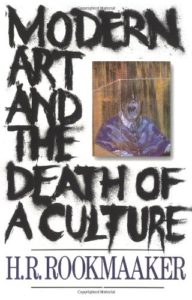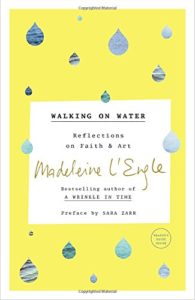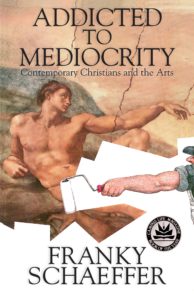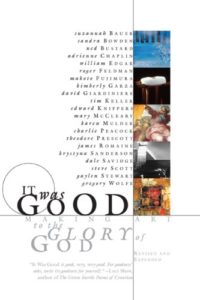In part 1, we shared four books that dig into what it means to be an artist not only in a secular culture, but also in a modern church culture that hasn’t always supported arts or artists. Here’s part two of 8 great reads on Christians and the arts…
 Modern Art and the Death of a Culture, by H.R. Rookmaaker. After a brief, but effective, dip into art history, Rookmaaker burrows to the roots of contemporary culture, and then steps boldly into modern art of the 20th century before finishing with thoughts on living out faith in the culture that God has placed us. Rookmaaker is at his strongest when offering observations on modern art that can only come from a Christian worldview…
Modern Art and the Death of a Culture, by H.R. Rookmaaker. After a brief, but effective, dip into art history, Rookmaaker burrows to the roots of contemporary culture, and then steps boldly into modern art of the 20th century before finishing with thoughts on living out faith in the culture that God has placed us. Rookmaaker is at his strongest when offering observations on modern art that can only come from a Christian worldview…
“This art is the work of your neighbors, your contemporaries, human beings who are crying out in despair for the lost of their humanity, their values, their lost absolutes, groping in the dark for answers. It is already late, if not too late, but if we want to help our generation we must hear their cry. We must listen to them as they cry out from their prison, the prison of a universe which is aimless, meaningless, absurd.”
As an honorable mention, Rookmaaker’s book The Creative Gift, is an outstanding collection of essays on art and the Christian life.
 Walking on Water, by Madeleine L’Engle. If nothing else, L’Engle knows how to stir the imagination, whether you’re a nine-year old experiencing A Wrinkle in Time, or an ninety-year old wrinkling with time. L’Engle’s reflections on faith and art masterfully blend the inherent mysticism of art with the striking reality that we are not fully alive unless we are creators…
Walking on Water, by Madeleine L’Engle. If nothing else, L’Engle knows how to stir the imagination, whether you’re a nine-year old experiencing A Wrinkle in Time, or an ninety-year old wrinkling with time. L’Engle’s reflections on faith and art masterfully blend the inherent mysticism of art with the striking reality that we are not fully alive unless we are creators…
“What do I mean by creators? Not only artists, whose acts of creation are the obvious ones of working with paint or clay or words. Creativity is a way of life, no matter what our vocation or how we earn a living. Creativity is not limited to the arts or having some kind of important career. Several women have written to me to complain about A Swiftly Tilting Planet. They feel that I should not have allowed Meg Murry to give up a career by marrying Calvin, having children, and quietly helping her husband with his work behind the scenes. But if women are to be free to choose a career as well as marriage, they must also be free to choose the making of a home and the nurture of a family as their vocation; that was Meg’s choice, and a free one, and it was as creative a choice as if she had gone on to get a Ph.D. in quantum mechanics. Our freedom to be creators is far less limited than some people would think.”
 Addicted to Mediocrity, 20th Century Christians and the Arts, by Franky Schaeffer. Scathing. Raw. True. This is the book to read if you want to be jolted, confirmed in your convictions, and encouraged by someone who knows you’ve likely be ignored by the church. Kurt Mitchell’s illustrations are perfect.
Addicted to Mediocrity, 20th Century Christians and the Arts, by Franky Schaeffer. Scathing. Raw. True. This is the book to read if you want to be jolted, confirmed in your convictions, and encouraged by someone who knows you’ve likely be ignored by the church. Kurt Mitchell’s illustrations are perfect.
Although most of the book is at nearly rant level (and that’s a good thing!), this excerpt focuses on a key understanding of God…
“We could live in a flat uninteresting world, one that had the bare minimum of gray ingredients to support life, one whose diversity was only enough to provide the minimum of existence. Instead, we live in a riotous explosion of diversity and beauty. We live in a world full of ‘useless’ beauty, we live in a world of millions of species, we live in a world peopled by individuals of infinite variety, talents, abilities, and this is only on our planet. When one looks heavenward and sees the complexity of the reaches of space above us, the mind boggles at the creativity of God.”
 It was Good, Making Art to the Glory of God, by Ned Bustard (author, editor.) A collection of 21 essays on art, art-making and artists. Featured contributors include Makoto Fujimura, Tim Keller, Charlie Peacock, and Steve Scott. Bustard organized and published these essays, and contributes a chapter on “good.”
It was Good, Making Art to the Glory of God, by Ned Bustard (author, editor.) A collection of 21 essays on art, art-making and artists. Featured contributors include Makoto Fujimura, Tim Keller, Charlie Peacock, and Steve Scott. Bustard organized and published these essays, and contributes a chapter on “good.”
From Bustard’s chapter… “God’s pronouncement on creation transcends mere usefulness because the evaluation of creation’s goodness came before anyone could use it. For example, following the creation of light, God said that, ‘it was good.’ This is not just a pragmatic ‘good,’ because at that point in the sequence of creation there were no plants existing to conduct photosynthesis using the light, and no humans to work and play in the light. The light merely existed and it was good… The universe was made by God, it conformed to His nature, reflected His image and therefore was pronounced ‘good.’ Though it is drastically altered in the Fall, this goodness of creation has not been obliterated. It can still be seen in the beauty of the earth, and in Man the image-bearer of God.”
A companion collection of essays, also compiled by Bustard, is It was Good, Making Music to the Glory of God.
______________________________________________________
What books did I miss? Let me know in the comment section.
